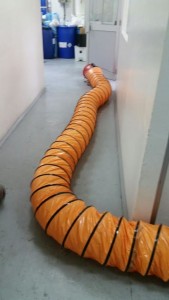Even if you’re not carrying out the painting services yourself, you tend to want to know the steps taken when it comes to industrial painting such as for factories, warehouses, production floors, garages, etc, because proper planning prior to the painting process is necessary in order to ensure smooth operation of the site and to reduce business down-time to the minimal.
Planning Industrial Painting Schedule
Work Hours
There are a number of critical considerations before starting on any painting works on industrial sites. The most difficult part to co-ordinate is to work within after-work hours. This means industrial painting contractors are only left with night hours, the wee morning hours and weekends to do the job.
Depending on the scale of the painting job, we may need to complete the work over a few weekends.
Painting Preparation for Factory, Warehouse, Industrial Office Painting for Companies
Hazardous Environment
There are a lot of details to look out for before commencing on a painting job on industrial sites. There are often chemicals, toxins and flammable inventory around industrial environments.
Hence we have to ensure that the handling of our paint supplies to be away from such fire hazards where potential combustion can occur.
Inaccessible Areas
As industrial spaces usually involves operational activities, bulky machines and equipment are commonly situated on site. These machinery are often too heavy and immobile, and have to be left in-situ. As such, when it comes to painting limited areas such as the floor area underneath them or the wall area behind them, we have to try our best to use designated painting tools to apply paint onto these areas where possible.
Where inaccessible, we’d have to seek the acknowledgement from the customers to exclude such areas in our painting coverage.
The Industrial Painting Process
Holding Area for Movable Inventory or Furniture
It is very important to identify a room or a area or spot for those items or furniture that are movable to this area, in which all of those can be contained temporarily before moving them to their original positions after all the paint work has been done.
This location is ideally as center of the affected area to be painted as possible so that it facilitates the moving around of the items better.
If the holding space is insufficient for all the movable inventory, we’ll plan it such that the items from the area situated deepest into the space to be moved out to the holding spot first, and then moving them back after that area has been painted and dried. The next steps to painting will then be worked in this manner from the inside out, so as to minimize unnecessary footfall to the painted spaces while they’re curing.
The Drying of Industrial Paint After the Painting Job is Completed
Smell/ Odour Control
Carrying out the paint job during off-work hours is not enough to eliminate the paint odour from the production workers. Industrial buildings and offices are often with centralized air-conditioning systems, hence the smell of paint still lingers for sometime even when the job is done.
While we’re unable to eliminate the odor completely, speeding up of the paint drying process is able to reduce the intensity of the smell. This is especially necessary for thicker paints such as epoxy flooring coating, or paints with higher VOCs (Volatile Organic Compounds), such as varnishes and lacquer.
